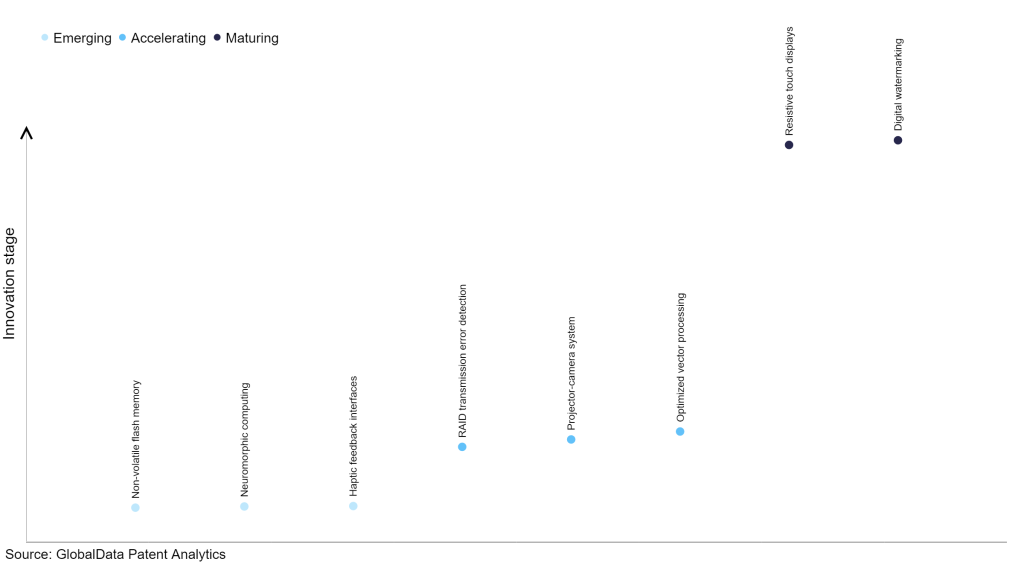The technology industry continues to be a hotbed of patent innovation. Activity is driven by the rapid emergence and widespread adoption of game-changing technologies such as artificial intelligence (AI), internet of things (IoT), and mobility, and growing importance of technologies such as content-addressable memory, dynamic random access memory, static random access memory, and non-volatile memory technologies. These technologies collectively enable multiple access memory arrays to provide concurrent access to memory cells by multiple operations, allowing for efficient and parallel data processing in various computing systems and applications. In the last three years alone, there have been over 1.5 million patents filed and granted in the technology industry, according to GlobalData’s report on Innovation in technology: multiple access memory arrays. Buy the report here.
However, not all innovations are equal and nor do they follow a constant upward trend. Instead, their evolution takes the form of an S-shaped curve that reflects their typical lifecycle from early emergence to accelerating adoption, before finally stabilizing and reaching maturity.
Identifying where a particular innovation is on this journey, especially those that are in the emerging and accelerating stages, is essential for understanding their current level of adoption and the likely future trajectory and impact they will have.
185+ innovations will shape the technology industry
According to GlobalData’s Technology Foresights, which plots the S-curve for the technology industry using innovation intensity models built on over 1.6 million patents, there are 185+ innovation areas that will shape the future of the industry.
Within the emerging innovation stage, non-volatile flash memory, neuromorphic computing, and haptic feedback interfaces are disruptive technologies that are in the early stages of application and should be tracked closely. RAID transmission error detection, projector-camera system, and optimized vector processing are some of the accelerating innovation areas, where adoption has been steadily increasing. Among maturing innovation areas are resistive touch displays and digital watermarking, which are now well established in the industry.
Innovation S-curve for the technology industry

Multiple access memory arrays is a key innovation area in technology
Multiple access memory arrays are memory systems in computers that enable multiple devices to access data simultaneously. These devices can include processors, storage systems, or other computer components. The purpose of these arrays is to enhance system performance by eliminating the necessity of maintaining multiple copies of the same data in different locations.
GlobalData’s analysis also uncovers the companies at the forefront of each innovation area and assesses the potential reach and impact of their patenting activity across different applications and geographies. According to GlobalData, there are 85+ companies, spanning technology vendors, established technology companies, and up-and-coming start-ups engaged in the development and application of multiple access memory arrays.
Key players in multiple access memory arrays – a disruptive innovation in the technology industry
‘Application diversity’ measures the number of applications identified for each patent. It broadly splits companies into either ‘niche’ or ‘diversified’ innovators.
‘Geographic reach’ refers to the number of countries each patent is registered in. It reflects the breadth of geographic application intended, ranging from ‘global’ to ‘local’.
Patent volumes related to multiple access memory arrays
Source: GlobalData Patent Analytics
Micron Technology is the top patent filer in multiple access memory arrays. The company’s patents are aimed at methods of operating a non-volatile memory module. The method may include filling a first plurality of pages of a first non-volatile memory with first data from a first data lane that includes a first volatile memory device and filling a second plurality of pages of the first non-volatile memory device with second data from a second data lane that includes a second volatile memory device. In certain examples, the first plurality of pages may not include data from the second data lane.
Other prominent patent filers in the space include SK Square and Samsung Group.
By geographic reach, Taiyo Yuden leads the pack, followed by Infineon Technologies and Micron Technology. In terms of application diversity, Micron Technology holds the top position, followed by ChangXin Memory Technologies and Samsung Group.
Multiple access memory arrays play a crucial role in improving system performance, reducing data transfer overhead, optimizing resource utilization, simplifying data coherency, and offering scalability and cost efficiency in various computing environments. They enable concurrent data access and processing, enhancing the overall efficiency and responsiveness of computer systems.
To further understand the key themes and technologies disrupting the technology industry, access GlobalData’s latest thematic research report on Technology.
Data Insights
From

The gold standard of business intelligence.
Blending expert knowledge with cutting-edge technology, GlobalData’s unrivalled proprietary data will enable you to decode what’s happening in your market. You can make better informed decisions and gain a future-proof advantage over your competitors.







